Resistance of Staphylococcus aureus to antimicrobial agents in Ethiopia: a meta-analysis
- PMID: 28852476
- PMCID: PMC5569497
- DOI: 10.1186/s13756-017-0243-7
Resistance of Staphylococcus aureus to antimicrobial agents in Ethiopia: a meta-analysis
Abstract
Background: Emergence of antimicrobial resistance by Staphylococcus aureus has limited treatment options against its infections. The purpose of this study was to determine the pooled prevalence of resistance to different antimicrobial agents by S. aureus in Ethiopia.
Methods: Web-based search was conducted in the databases of PubMed, Google Scholar, Hinari, Scopus and the Directory of Open Access Journals (DOAJ) to identify potentially eligible published studies. Required data were extracted and entered into Excel spread sheet. Statistical analyses were performed using Stata version 13.0. The metaprop Stata command was used to pool prevalence values. Twenty-one separate meta-analysis were done to estimate the pooled prevalence of the resistance of S. aureus to twenty-one different antimicrobial agents. Heterogeneity among the studies was assessed using the I2 statistic and chi-square test. Publication bias was assessed using Egger's test. Because of significant heterogeneity amongst the studies, the random effects model was used to pool prevalence values.
Results: The electronic database search yielded 1317 studies among which 45 studies met our inclusion criteria. Our analyses demonstrated very high level of resistance to amoxicillin (77% [95% confidence interval (CI): 68%, 0.85%]), penicillin (76% [95% CI: 67%, 84%]), ampicillin (75% [95% CI: 65%, 85%]), tetracycline (62% [95% CI: 55%, 68%]), methicillin (47% [95% CI: 33%, 61%]), cotrimoxaziole (47% [95% CI: 40%, 55%]), doxycycline (43% [95% CI: 26%, 60%]), and erythromycin (41% [95% CI: 29%, 54%]). Relatively low prevalence of resistance was observed with kanamycin (14% [95% CI: 5%, 25%]) and ciprofloxacin (19% [95% CI: 13%, 26%]). The resistance level to vancomycin is 11% 995% CI: (4%, 20%). High heterogeneity was observed for each of the meta-analysis performed (I2 ranging from 79.36% to 95.93%; all p-values ≤0.01). Eggers' test did not show a significant publication bias for all antimicrobial agents except for erythromycin and ampicillin.
Conclusions: S. aureus in Ethiopia has gotten notoriously resistant to almost to all of antimicrobial agents in use including, penicillin, cephalosporins, tetracyclines, chloramphenicol, methicillin, vancomycin and sulphonamides. The resistance level to vancomycin is bothersome and requires a due attention. Continued and multidimensional efforts of antimicrobial stewardship program promoting rational use of antibiotics, infection prevention and containment of AMR are urgently needed.
Keywords: Antimicrobial resistance; Ethiopia; Meta-analysis; Staphylococcus aureus.
Conflict of interest statement
Ethics approval and consent to participate
Not applicable.
Consent for publication
Not applicable.
Competing interests
The authors declare that they have no competing interests.
Publisher’s Note
Springer Nature remains neutral with regard to jurisdictional claims in published maps and institutional affiliations.
Figures


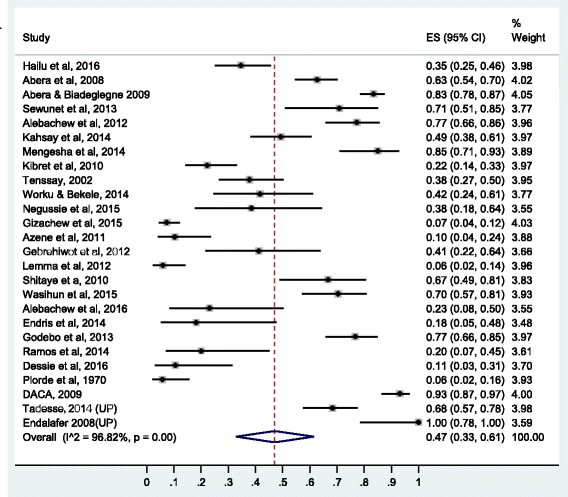
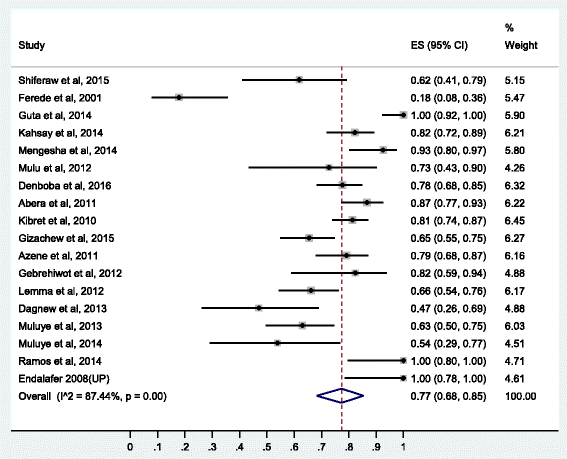

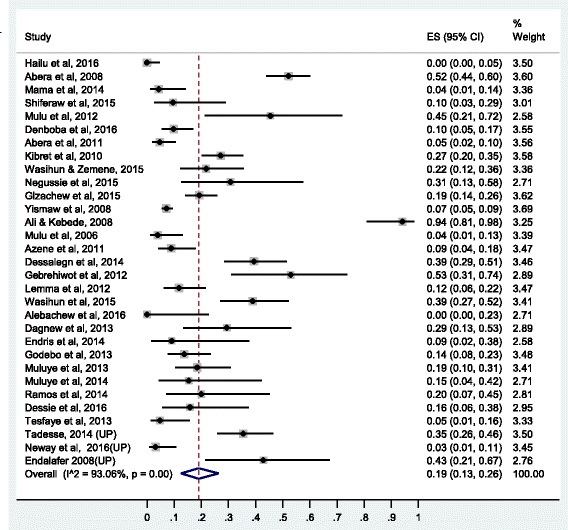
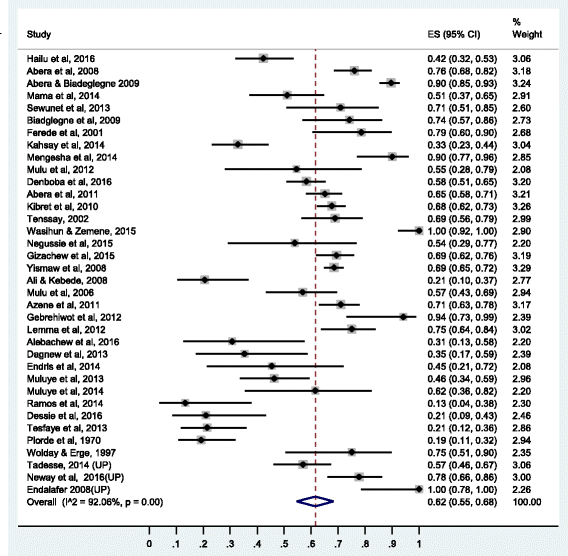

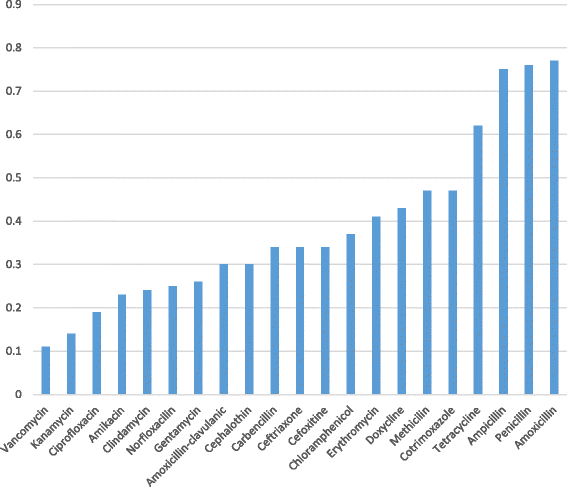
Similar articles
-
Prevalence and antimicrobial resistance of coagulase negative staphylococci clinical isolates from Ethiopia: a meta-analysis.BMC Microbiol. 2018 May 25;18(1):43. doi: 10.1186/s12866-018-1188-6. BMC Microbiol. 2018. PMID: 29801462 Free PMC article.
-
A meta-analysis on the prevalence of resistance of Staphylococcus aureus to different antibiotics in Nigeria.Antimicrob Resist Infect Control. 2023 Apr 25;12(1):40. doi: 10.1186/s13756-023-01243-x. Antimicrob Resist Infect Control. 2023. PMID: 37098614 Free PMC article. Review.
-
Prevalence of Vancomycin resistant enterococci (VRE) in Ethiopia: a systematic review and meta-analysis.BMC Infect Dis. 2020 Feb 11;20(1):124. doi: 10.1186/s12879-020-4833-2. BMC Infect Dis. 2020. PMID: 32046668 Free PMC article.
-
Quarter-wise proportion and beta-lactam resistance rate of bovine mastitis associated- Staphylococcus aureus among infectious episodes in Ethiopia: Systematic review and meta-Analysis.Heliyon. 2023 Jul 17;9(7):e18180. doi: 10.1016/j.heliyon.2023.e18180. eCollection 2023 Jul. Heliyon. 2023. PMID: 37519650 Free PMC article. Review.
-
Methicillin resistant Staphylococcus aureus in Ethiopia: a meta-analysis.BMC Infect Dis. 2016 Nov 21;16(1):689. doi: 10.1186/s12879-016-2014-0. BMC Infect Dis. 2016. PMID: 27871245 Free PMC article.
Cited by
-
Functionalization of ampicillin and gentamicin with biogenic copper nanoparticles (CuNPs) remodel antimicrobial and cytotoxic outcome against MDR clinical isolates.Arch Microbiol. 2023 Feb 13;205(3):88. doi: 10.1007/s00203-023-03425-y. Arch Microbiol. 2023. PMID: 36781492
-
Antimicrobial Resistance Patterns of Staphylococcus aureus and Enterococcus Species at the Ethiopian Public Health Institute, Ethiopia: A Five-Year Retrospective Analysis.Infect Drug Resist. 2023 Sep 13;16:6155-6166. doi: 10.2147/IDR.S429687. eCollection 2023. Infect Drug Resist. 2023. PMID: 37724092 Free PMC article.
-
Antimicrobial Activity of Selected Medicinal Plants from a Sub-Saharan African Country against Bacterial Pathogens from Post-Operative Wound Infections.Med Sci (Basel). 2021 Mar 31;9(2):23. doi: 10.3390/medsci9020023. Med Sci (Basel). 2021. PMID: 33807402 Free PMC article.
-
Methicillin-resistant Staphylococcus aureus antibiotic susceptibility profile and associated factors among hospitalized patients at Hawassa University Comprehensive Specialized Hospital, Ethiopia.IJID Reg. 2022 Mar 25;3:129-134. doi: 10.1016/j.ijregi.2022.03.015. eCollection 2022 Jun. IJID Reg. 2022. PMID: 35755464 Free PMC article.
-
Guideline Recommendations for Empirical Antimicrobial Therapy: An Appraisal of Research Evidence for Clinical Decision-Making in Ethiopia.Infect Dis Ther. 2020 Sep;9(3):451-465. doi: 10.1007/s40121-020-00308-3. Epub 2020 Jun 22. Infect Dis Ther. 2020. PMID: 32572787 Free PMC article. Review.
References
-
- Lowy FD. Staphylococcus aureus infections. N Engl J Med. 1998;339(8):520–532. - PubMed
-
- Hiramatsu K. Mechanism of methicillin resistance and genetic background of Staphylococcus Aureus. Nihon Naika Gakkai Zasshi. 1992;81(10):1592–1598. - PubMed
-
- Hiramatsu K, Hanaki H, Ino T, Yabuta K, Oguri T, Tenover FC. Methicillin-resistant Staphylococcus Aureus clinical strain with reduced vancomycin susceptibility. J Antimicrob Chemother. 1997;40:135–136. - PubMed
LinkOut - more resources
Full Text Sources
Other Literature Sources
Miscellaneous

